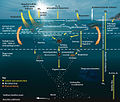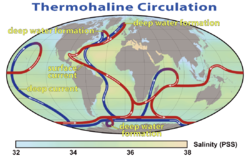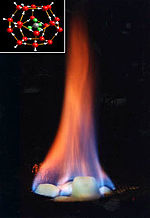Sea Ice Microbial Communities (SIMCO) refer to groups of microorganisms living within and at the interfaces of sea ice at the poles. The ice matrix they...
27 KB (3,348 words) - 22:50, 14 October 2024
Marine microorganisms (redirect from Sea microbial)
carbon. Sea ice microbial communities (SIMCO) refer to groups of microorganisms living within and at the interfaces of sea ice at the poles. The ice matrix...
232 KB (21,388 words) - 09:27, 7 February 2025
figure. Sea ice Sea ice microbial communities Sea ice emissivity modeling Sea ice growth processes Sea ice concentration Sea ice thickness Sea ice physics...
26 KB (2,795 words) - 22:17, 30 March 2025
to grab for any person who falls through. Polar ice cap Sea ice Sea ice microbial communities Frazil ice Cooper, Donald C. (2005). Fundamentals of Search...
11 KB (1,286 words) - 15:47, 4 December 2024
Ice algae are any of the various types of algal communities found in annual and multi-year sea, and terrestrial lake ice or glacier ice. On sea ice in...
40 KB (4,817 words) - 20:56, 4 December 2024
Riff Raff (rapper) (born Horst Simco; 1982), American rapper Sea ice microbial communities (SIMCO) Simco, a European real estate company acquired by Gecina...
704 bytes (130 words) - 02:29, 21 June 2024
temperature change, which means that microbial life within brine pockets must be flexible to environmental change. As sea ice forms, the water freezes into a...
36 KB (4,481 words) - 16:07, 19 January 2025
Phytoplankton microbiome (section Composition and diversity of phytoplankton-associated microbial communities)
bacterioplankton community. Microbial communities in these systems are shaped by deterministic processes, enhancing host function, while free-living communities are...
39 KB (4,341 words) - 04:08, 5 May 2025
Microbiome (redirect from Microbial interaction)
defined more precisely in 1988 by Whipps et al. as "a characteristic microbial community occupying a reasonably well-defined habitat which has distinct physio-chemical...
134 KB (11,925 words) - 06:31, 9 April 2025
Blood Falls (section Microbial ecosystem)
Earth hypothesis) was entirely frozen over. Ice-covered oceans might have been the only refugium for microbial ecosystems when the Earth apparently was covered...
12 KB (1,329 words) - 12:09, 26 March 2025
(2012). "Recent Advances and Future Perspectives in Microbial Phototrophy in Antarctic Sea Ice". Biology. 1 (3): 542–556. doi:10.3390/biology1030542...
162 KB (16,701 words) - 23:02, 13 March 2025
the existence of uniquely adapted microbial communities, high rates of biogeochemical and physical weathering in ice sheets, and storage and cycling of...
55 KB (11,621 words) - 20:30, 7 April 2025
aggregate-enriched biofilm environment with distinct microbial communities. Because of its unique position at the air-sea interface, the SML is central to a range...
77 KB (8,710 words) - 04:19, 29 January 2025
Airborne microbial communities play significant roles in public health and meteorological processes, so it is important to understand how these communities are...
171 KB (17,476 words) - 16:35, 30 April 2025
commonly found below polar sea ice and in the deep ocean. This below-sea ice forms through a process called brine rejection. For deep-sea brine pools, salt is...
64 KB (6,897 words) - 18:37, 4 May 2025
Outline of oceanography (section Sea ice)
growth processes – Sea ice microbial communities – Groups of microorganisms living within and at the interfaces of sea ice Sea ice thickness – Stamukha...
226 KB (32,627 words) - 21:34, 2 April 2025
evaluating microbial communities in Antarctic lakes, exploration of Mars via the Curiosity rover, and characterization of microbial communities in the lab...
24 KB (1,860 words) - 06:55, 11 January 2025
Ediacaran biota (section Microbial mats)
the sea floor. Putative "burrows" dating as far back as 1,100 million years may have been made by animals that fed on the undersides of microbial mats...
106 KB (11,175 words) - 14:18, 22 May 2025
Bathypelagic zone (section Microbial ecology)
deeper water did not have suitable physical conditions for diverse microbial communities. The bathypelagic zone receives inputs of organic material and POM...
50 KB (5,362 words) - 11:43, 22 May 2025
as historical events that can leave lasting signatures on microbial communities. Microbial biogeographic patterns are often similar to those of macro-organisms...
19 KB (2,327 words) - 16:32, 14 March 2024
Arctic has contributed to thawing permafrost, retreat of glaciers and sea ice decline. Higher temperatures are also causing more intense storms, droughts...
318 KB (28,559 words) - 13:29, 22 May 2025
October 2023). "Methylotrophic Communities Associated with a Greenland Ice Sheet Methane Release Hotspot". Microbial Ecology. 86 (4): 3057–3067. Bibcode:2023MicEc...
164 KB (17,010 words) - 19:14, 27 March 2025
Methane clathrate (redirect from Methane ice)
with water within the sea bed subject to temperature and pressure. In 2008, research on Antarctic Vostok Station and EPICA Dome C ice cores revealed that...
52 KB (9,379 words) - 08:25, 9 April 2025
have found microbial communities apparently based on the products of reactions between water and the constituents of rocks. These communities have not been...
53 KB (6,328 words) - 02:08, 20 May 2025
1996 Molecular ecology of aquatic communities. With J. P. Zehr, 1999 Preliminary assessment of microbial communities and biodegradation of chlorinated...
11 KB (1,068 words) - 22:02, 9 January 2025
United States Antarctic Program (USAP) field team leader for Sea Ice Microbial Communities (SIMCO) studies in McMurdo Sound, 1980–86, 1988, 1989; chief...
2 KB (281 words) - 00:32, 29 April 2022
Psychrophile (category Microbial growth and nutrition)
polar ice, glaciers, snowfields and deep ocean waters. These organisms can also be found in pockets of sea ice with high salinity content. Microbial activity...
29 KB (3,228 words) - 23:38, 23 November 2024
other planets constitute potential refugia for extraterrestrial microbial communities. The term "endolith", which defines an organism that colonizes the...
32 KB (3,629 words) - 05:24, 7 April 2025
the limits of microbial life in solutions with high salt concentrations at low temperature. Any body of liquid water under the polar ice caps or underground...
213 KB (20,771 words) - 17:00, 22 May 2025
Cold seep (section Chemosynthetic communities)
those from shelf depths. Deep-sea seeps sediments are highly heterogeneous. They sustain different geochemical and microbial processes that are reflected...
98 KB (11,187 words) - 21:11, 19 March 2025






















